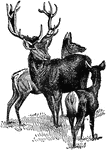Clipart tagged: ‘antlers’

American Elk
"is a large and noble species, resembling the red deer of europe; is has tall, round, branching horns,…

Stag
"Stag, or Red Deer, is a typical species of deer, occurring in the N. of Europe and Asia. It was once…
